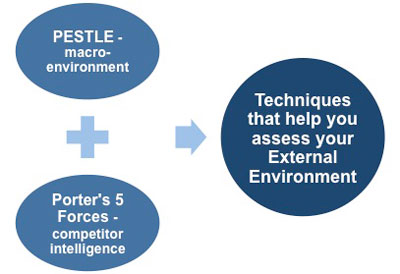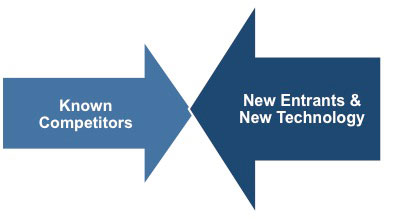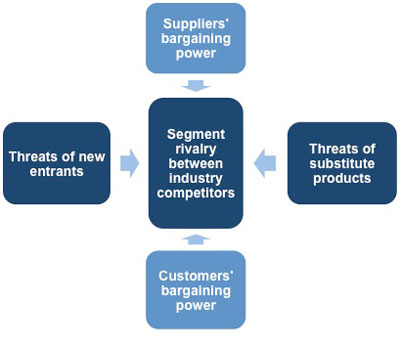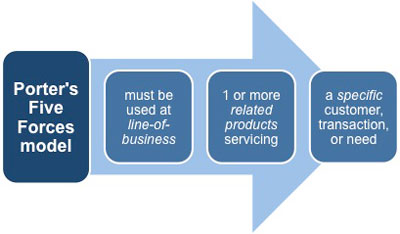Introduction to Porters Five Forces

Any organizational strategy that you develop needs to include gaining a thorough understanding of the external environment that the organization is operating in. The two most widely used tools that can help you to do this are the PESTLE Analysis and Porter's Five Forces Analysis.
The PESTLE Analysis enables you to create a list of the potential issues within your macro-environment that have or could have implications for your organization. If you are unfamiliar with this analysis technique or want to understand it in greater detail then download our free 'PESTLE Analysis' business strategy eBook.
 |
Whilst understanding the macro-environment is essential for developing your strategy it only gives you half of the picture. You also need to have a thorough understanding of your competitors and the impact they can have on your organization. To gain this knowledge you need to conduct Porter's Five Forces Analysis.
In 1979 Michael E. Porter of Harvard Business School identified five key forces that determined the fundamental attractiveness of a market or a market sector in the long term.
This became known as Porter's Five Forces Analysis and it provides a model that enables organizations to analyze their industry in a way that takes your competitors' activities into account. This is a vital part of creating a strategy, and it is important that managers understand how it works and how to contribute to it.
One of the most crucial aspects of using this technique is your organization's ability to define its market properly. Defining your market too narrowly, known as 'marketing myopia,' can make it impossible to work out who your competitors are in terms of market need and opportunities.
An example frequently quoted by marketing professionals is that of Coca-Cola: Coca-Cola defined its market and therefore its competitors as being in the 'soft drinks' market. This definition was too narrow and was not based on the needs of their customers; more realistically the market should have been described as 'social and snack-time' drinks.
If Coca-Cola had defined it as such then the company would have been better prepared for the impact coffee bars (Starbuck's, Costa Coffee, etc.) and the fresh fruit juice bars (Juice Stop, Juice Fix, Froot Smoothies, etc.) would have on its business.
Porter's analysis technique has become popular with business and strategy analysts and is often regarded as a credible and more practical alternative to the widely used SWOT Analysis. This is because it looks at the forces your competitors can exert on your market and how this could affect your organization and its long-term success.
If you are unfamiliar with the SWOT Analysis technique or want to understand it in greater detail then visit our website www.free-management-eBook s.com and download our free 'SWOT Analysis' eBook.
 |
In today's highly competitive markets any successful organization will have a reasonable level of intelligence on its known competitors. But as recent events have shown, the greatest harm to your organization is unlikely to come from this quarter. Your greatest threats are more likely to come from new and emerging competitors or new technologies. For example,
New Entrant - Consultancy services supplier Tata was a new entrant from India and has been able to make serious inroads into the market. Existing suppliers such as EDS and Accenture have struggled to retain their market share since Tata's arrival.
New Technology - the success of eBook readers such as Kindle have found the publishing industry struggling to respond. A recent article in trade magazine Publishers Weekly stated that eBooks accounted for around a third of all book spending.
Porter's model considers five forces that determine the 'attractiveness' of your market by analyzing the competitive intensity. What he meant by a particular market being 'attractive' was its overall industry profitability, which was assessed by looking at potential opportunities and risks.
 |
The five key factors the model uses to identify and evaluate potential opportunities and risks are:
• Competitive Rivalry
• Threat of New Entrants
• Threat of Substitutes
• Bargaining Power of Suppliers
• Bargaining Power of Customers
The first three are considered to be 'horizontal' competition (shown as dark blue in the diagram) because each force is operating in the same way within the market. The remaining two forces are classified as 'vertical' competition (light blue) because they operate within the supply chain.
It is important to remember when using Porter's Five Forces as part of your strategic analysis that the method was designed for use at the line-of-business level. 'Line-of-business' is defined as applying to a set of one or more highly related products that service a particular customer transaction or business need.
 |
If your organization has a diverse portfolio of products and services, then it must create a separate model for each of these areas. Understanding the dynamics of Porter's model is vital to successfully making informed decisions as part of your strategy process and you need to remember that it is not appropriate to use at the overall business level.
If an electrical retailer, for instance, had a large portfolio of products, they would need to develop separate Five Forces models for each range. For example:
• White goods (fridges, freezers, dishwashers, etc.)
• Small kitchen appliances
• Mobile phones
• Computers, laptops, and printers
• Camera equipment
• Television and home cinema
Each product range is quite separate from the others and the five factors affecting each one are quite specific. It is only by performing a separate analysis for each range that you will gain the level of understanding you need to be successful in each line of business.
Organizations use this Five Forces Analysis to help them make a qualitative evaluation of their strategic position at the start of the development or review process. This technique is suited to helping you identify potential opportunities, especially if you are considering entering a new market, or you are seeking effective ways to differentiate yourself from the competition.
You may also be interested in: Introduction to Porter's Five Forces Analysis, Competitive Rivalry, Threat of New Entrants, Threat of Substitutes, Bargaining Power of Suppliers, Bargaining Power of Customers and Advantages and Disadvantages of Porter's Five Forces Analysis.



